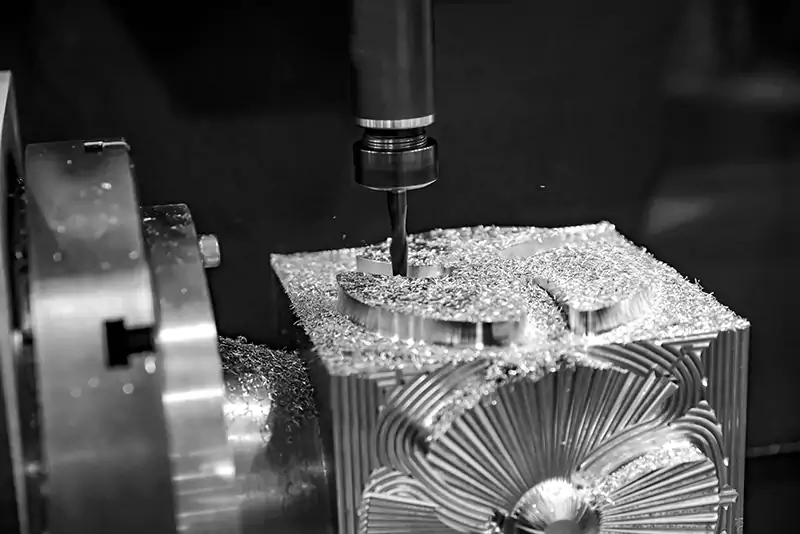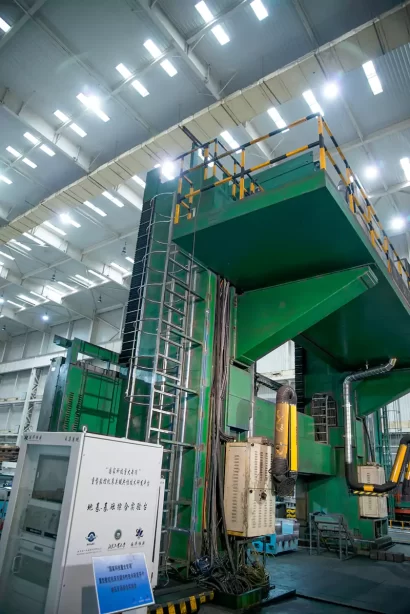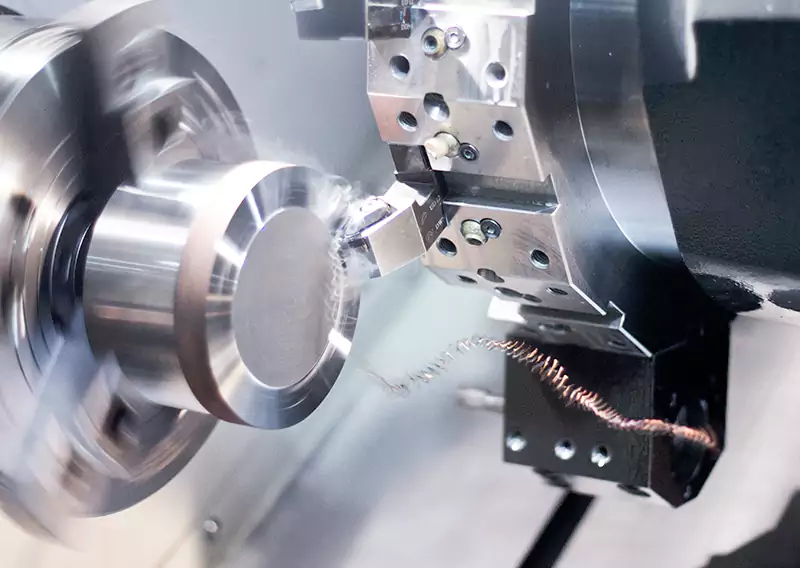How CNC Milling Works
What is CNC Milling
CNC milling is a manufacturing process in which a computer-controlled machine tool removes material from a solid block of material (known as the workpiece) to create a custom-designed part or product. The letters “CNC” stand for “Computer Numerical Control,” which means that the milling machine is programmed using computer software to guide its cutting tools along a pre-determined path to create the desired shape.

The CNC milling process
Developed in the 1950s, CNC technology took a significant leap forward with the introduction of computers in the 1980s. The CNC process begins with a two-dimensional or three-dimensional rendering created by a computer, unlike other production methods. Instructions are created using CAD, computer-aided design, for CNC machines to follow.
CAD software precisely defines the measurements and requirements for the part. It is used by engineers and designers to examine, enhance, and approve prototypes. Through this method, they can examine their ideas minutely without the need to produce a prototype on a machine. CAD offers the benefits of safely working on a concept without a loss of time or labor. There are many items on the market today that were first designed using CAD software.
In order to program the CNC machine, a part must be converted into a programming language. The instructions for the CNC machine are converted into general or miscellaneous code, G-Code or M-Code, using CAM, computer-aided manufacturing.
The translated information is sent on to production for the setup of the CNC machine and downloading of the CAD programming. Adding tools, inserting raw material, and testing the process are all parts of setting up the equipment. Once the CNC machine is programmed, the raw material or workpiece is inserted. To create a finished product, the machine automatically executes the programmed instructions.
In addition to metal, plastic, glass, and wood, CNC is capable of reshaping a variety of other materials as well. It can be programmed to produce custom designed parts to exacting and accurate specifications in minutes. A variety of products are produced efficiently and economically using CNC in modern manufacturing.
Since 1952, CNC milling has been the most common form of CNC processing. Since the early 19th century, milling has been one of the oldest manufacturing processes. Because it is designed to remove material from a workpiece, it is a perfect partner for the CNC method.
CNC Milling Machines

A CNC milling machine is a type of machine tool that uses computer numerical control (CNC) technology to automate the machining process. CNC milling machines are widely used in the manufacturing industry to produce high-precision components for various applications.
The basic principle of a CNC milling machine is to remove material from a workpiece by rotating a cutting tool at high speed while the workpiece is held stationary. The cutting tool is controlled by a computer program that determines the tool path and the cutting parameters such as speed, feed rate, and depth of cut.
CNC milling machines come in various types and sizes, ranging from small tabletop machines used for hobby or educational purposes to large industrial machines used for high-volume production. Some common types of CNC milling machines include vertical milling machines, horizontal milling machines, and gantry milling machines.
Vertical milling machines
Vertical milling machines are the most common type of milling machine and are typically used to mill flat surfaces or slots in a workpiece. The cutting tool is mounted vertically and moves up and down to cut the workpiece.
Horizontal milling machines
Horizontal milling machines are a type of milling machine that has the cutting tool mounted horizontally instead of vertically. They are typically used to mill slots, grooves, or other flat surfaces on a workpiece. The machines are often used in heavy-duty machining operations and are commonly found in manufacturing plants that produce large quantities of metal components.
Gantry milling machines
Gantry milling machines are larger machines that are used for heavy-duty machining operations. They are typically used to mill large parts or components that require a high level of precision. Gantry milling machines have a bridge-like structure that spans the width of the work area and allows the cutting tool to move in multiple directions.
Advantages of CNC Milling Machine
One of the main advantages of CNC milling machines is their ability to produce high-precision components with a high degree of accuracy and repeatability. This makes them ideal for producing complex parts with tight tolerances. CNC milling machines are also highly efficient and can produce parts at a much faster rate than manual milling machines.
Another advantage of CNC milling machines is their flexibility. With a CNC milling machine, you can easily change the cutting parameters to produce different types of parts or components. This makes them ideal for use in a variety of industries, including aerospace, automotive, medical, and electronics.
In addition to their precision and flexibility, CNC milling machines are also highly versatile. They can be used to machine a wide range of materials, including metals, plastics, and composites. This makes them ideal for producing parts for a variety of applications, from simple brackets to complex aerospace components.
While CNC milling machines offer many advantages over manual milling machines, they also require a higher level of technical expertise to operate. CNC milling machines require skilled operators who are familiar with computer programming and machining operations. In addition, CNC milling machines are typically more expensive than manual milling machines, which may be a barrier for some small businesses or hobbyists.
Types of CNC Milling

The accuracy of CNC milling makes it suitable for a variety of industries. With the help of a CAD program, CNC milling can be used to create prototypes for examination, one-off parts, multiple-part assemblies, and small runs. Its versatility makes it a popular production method. CNC milling has four common milling processes.
Face milling
In face milling, the cutter axis is oriented at right angles to the flat surface. The cutters for this process have teeth on the periphery and tool face. With peripheral teeth cutting, and face teeth finishing, each set of teeth has a specific function. The face milling method produces better finishes and can be used vertically or horizontally.
Plain milling
When the milling cutter axis is parallel to the surface being milled, it is called plain milling, surface milling, or slab milling. On a milling machine table, the workpiece is mounted parallel to the surface, and the cutter is mounted on a milling machine arbor. Several arbor supports are located between the spindle and arbor supports of the milling machine. The workpiece is clamped directly to the table. There are teeth on the periphery of plain milling tools.
Depending on the surface size, narrow cutters can make deep cuts and wide cutters can make large cuts. Operators use coarse-toothed cutters, slow cutting speeds, and fast feed rates to produce approximate geometry of parts that require large amounts of material to be removed, followed by finer toothed cutters, faster cutting speeds, and slower feed rates when details are required.
Angular milling
Angle milling refers to milling flat surfaces at an angle to the workpiece’s surface. Angle milling cutters are used to mill angular surfaces such as chamfers, serrations, and grooves. As an example of angular milling, dovetail milling uses an angle of 45°, 50°, 55°, or 60° based on the design. After roughing out the tongue or groove with a side milling cutter, angle milling cutters are used to finish the angular sides and base.
Form milling
Using form milling, you can mill irregular surfaces such as curves, flats, or all curves. Forming can be done in a single cut using a milling cutter or fly cutter shaped to the contour of the cut. Common form milling involves milling half-round recesses and beads or quarter-round radii on workpieces. Depending on the circular diameter that is required, form milling cutters can be convex, concave, or corner rounding cutters. With form milling, you can create intricate patterns or mill several complex surfaces at once. This process can also be used to shape hemispherical and semi-circular cavities, beads, and contours.
Specialized Milling Operations
Gear cutting
Gear cutting machines are used to rough out and finish gear teeth, fit gears, and fine finish and round off the butt ends of gear teeth. They are used to make spur, helical, herringbone, and worm gears. Both movable and stationary stands are available for vertical models. Cutters come in different shapes and sizes depending on the number of teeth for the gear design.
Straddle milling
The straddle milling process involves machining two or more parallel vertical surfaces at a single time by mounting two milling cutters on the same arbor, separated at a precise angle. Both sides of the workpiece are machined simultaneously with exact and precise dimensions. Indexing fixtures or vertical swivel vises hold the workpiece.
Profile milling
In profile milling, different milling cutters are used to rough or finish vertical or slanted surfaces and multi-axes can be used for 2D and 3D convex and concave shapes. The cutting tools can be parallel or perpendicular to the plane of the workpiece. In general, round inserts and radius concept cutters are used for roughing and semi-roughing, while ball nose end mills are used for finishing.
Gang milling
During gang milling, multiple cutters are used to machine multiple surfaces of a workpiece at the same time. The cutters may be the same diameter or different. The process can produce more intricate cuts for complex parts and shorten production time. Gang milling is the perfect choice when several cuts are needed, such as slots, flats, and angular grooves.
Specialized milling functions represent just a portion of the total number of unique milling equipment available. As more complex designs and parts are developed, new types of milling methods will be invented. Even though milling is an old process, it has become an integral part of modern manufacturing.
Conclusion
CNC machine tools are used in a variety of industries for a variety of purposes. As the famous futurist Ray Kurzweil once said: “Our technology, our machines, is part of our humanity. We created them to extend ourselves, and that is what is unique about human beings.” Regardless of what industry you are in, CNC machining practices will definitely meet your needs. Therefore, you should be able to tell which one is suitable for you.